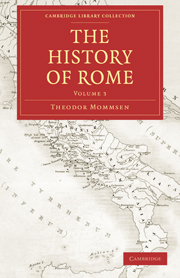Book contents
- Frontmatter
- PREFATORY NOTE
- Contents
- BOOK FOURTH: THE REVOLUTION
- CHAPTER I THE SUBJECT COUNTRIES DOWN TO THE TIMES OF THE GRACCHI
- CHAPTER II THE REFORM MOVEMENT AND TIBERIUS GRACCHUS
- CHAPTER III THE REVOLUTION AND GAIUS GRACCHUS
- CHAPTER IV THE RULE OF THE RESTORATION
- CHAPTER V THE PEOPLES OF THE NORTH
- CHAPTER VI THE ATTEMPT OF MARIUS AT REVOLUTION AND THE ATTEMPT OF DRUSUS AT REFORM
- CHAPTER VII THE REVOLT OF THE ITALIANS AND THE SULPICIAN REVOLUTION
- CHAPTER VIII THE EAST AND KING MITHRADATES
- CHAPTER IX CINNA AND SULLA
- CHAPTER X THE SULLAN CONSTITUTION
- CHAPTER XI THE COMMONWEALTH AND ITS ECONOMY
- CHAPTER XII NATIONALITY, RELIGION, AND EDUCATION
- CHAPTER XIII LITERATURE AND ART
- CORRECTIONS
CHAPTER V - THE PEOPLES OF THE NORTH
Published online by Cambridge University Press: 05 October 2010
- Frontmatter
- PREFATORY NOTE
- Contents
- BOOK FOURTH: THE REVOLUTION
- CHAPTER I THE SUBJECT COUNTRIES DOWN TO THE TIMES OF THE GRACCHI
- CHAPTER II THE REFORM MOVEMENT AND TIBERIUS GRACCHUS
- CHAPTER III THE REVOLUTION AND GAIUS GRACCHUS
- CHAPTER IV THE RULE OF THE RESTORATION
- CHAPTER V THE PEOPLES OF THE NORTH
- CHAPTER VI THE ATTEMPT OF MARIUS AT REVOLUTION AND THE ATTEMPT OF DRUSUS AT REFORM
- CHAPTER VII THE REVOLT OF THE ITALIANS AND THE SULPICIAN REVOLUTION
- CHAPTER VIII THE EAST AND KING MITHRADATES
- CHAPTER IX CINNA AND SULLA
- CHAPTER X THE SULLAN CONSTITUTION
- CHAPTER XI THE COMMONWEALTH AND ITS ECONOMY
- CHAPTER XII NATIONALITY, RELIGION, AND EDUCATION
- CHAPTER XIII LITERATURE AND ART
- CORRECTIONS
Summary
Relations of Rome to the north
From the close of the sixth century the Roman community ruled over the three great peninsulas projecting from the northern continent into the Mediterranean, at least taken as a whole. Even there however—in the north and west of Spain, in the valleys of the Ligurian Apennines and the Alps, and in the mountains of Macedonia and Thrace—tribes wholly or partially free continued to defy the negligent Roman government. Moreover the continental communication between Spain and Italy as well as between Italy and Macedonia was very superficially provided for, and the countries beyond the Pyrenees, the Alps, and the Balkan chain—the great river-basins of the Rhone, the Ehine, and the Danube—in the main lay beyond the political horizon of the Romans. We have now to set forth what steps were taken on the part of Rome to secure and to round oif her empire in this direction, and how at the same time the great masses of peoples, who were ever moving to and fro behind that mighty mountain-screen, began to beat at the gates of the northern mountains and rudely to remind the Græco-Roman world that it was mistaken in believing itself the sole possessor of the earth.
The country between the Alphs and Pyrenees
Let us first glance at the region between the western Alps and the Pyrenees. The Romans had for long commanded this part of the coast of the Mediterranean through their client city of Massilia, one of the oldest, most faithful, and most powerful of the allied communities dependent on Rome.
- Type
- Chapter
- Information
- The History of Rome , pp. 166 - 195Publisher: Cambridge University PressPrint publication year: 2010First published in: 1863



